AN/TVS 3 Searchlight
Main Navigation
AN/TVS 3 Searchlight

This is an AN/TVS 3 20KW Liquid-Cooled Xenon Searchlight. In the late 1960's and early 1970's, approximately 200 of these lights were produced in secret design and manufacturing programs pursuant to military contracts by Varo, Inc. in Texas and Strong Electric Co. in Ohio. These lights were originally designed for illuminating tank battlefields. Before night vision technologies were developed, US Army artillery brigades had searchlight units to provide artificial moonlight bright enough to sustain night operations. These units were sometimes referred to as "movement light" units.
These particular searchlights were specified by the US Army Electronic Command to surpass the performance of the gigantic 60 inch carbon arc antiaircraft searchlights that were produced by the thousands for WWII. What the Army got for it's money (about $23,000 each in 1967 dollars) was a relatively compact 30 inch diameter unit that was likely the world's most powerful mass produced searchlight. The AN-TVS-3 provided an unparalleled 1.3 billion candlepower beam that stretched over 8 miles. At the heart of these lights were huge "short arc" lamps (light bulbs) that had one inch thick quartz glass envelopes filled with xenon gas under high pressure. The lamps burned so hot that engineers added a special liquid cooling system to supplement the forced air cooling system. At full power, the lights consumed around 450 amps of 200V 3 ph AC 400hz electricity.

When introduced into active duty in the late 1960's, AN/TVS 3's were the subject of many legends. Soldiers were told that these searchlights could cause sunburns from over a mile away. Allegedly, the beams could ignite trees, kill bugs, and knock birds from the air. Even though these claims were somewhat exaggerated, some of the most incredible claims turned out to be true. For instance, some soldiers who looked directly into the front of the lights without eye protection suffered temporary blindness. AN/TVS 3's did indeed emit dangerous levels of ultraviolet radiation, electromagnetic interference, and ozone, but only if the covers were open or the shielding was removed. If overheated or mishandled, the lamps were actually capable of exploding with the force of a grenade. When weather conditions were ideal, the beams did in fact extend all the way into outer space.
A couple of years ago I spoke with a retired engineer from Varo, Inc., one of the two contractors that designed and manufactured these lights. He said that the AN/TVS 3 program was considered "Top Secret" in the 1960's, and the team that worked on the lights always operated behind locked doors separated from the other design groups at Varo, Inc. About half the light generated was infrared, meaning it was not visible to the human eye. Engineers designed a filter that took out all the visible light and made it possible for the AN/-VS-3's to shed vast amounts of invisible infrared light to enhance early (top secret) night vision technologies.
Recently, I traded emails with a US Army veteran who operated AN/TVS 3's in the 1960's. He confirmed that the lights were considered "Top Secret" for a time. But, they became public knowledge after an article in Reader's Digest disclosed the existence of the US Army's "super high intensity xenon lights". After that, the lights were occasionally put out for public exhibitions.
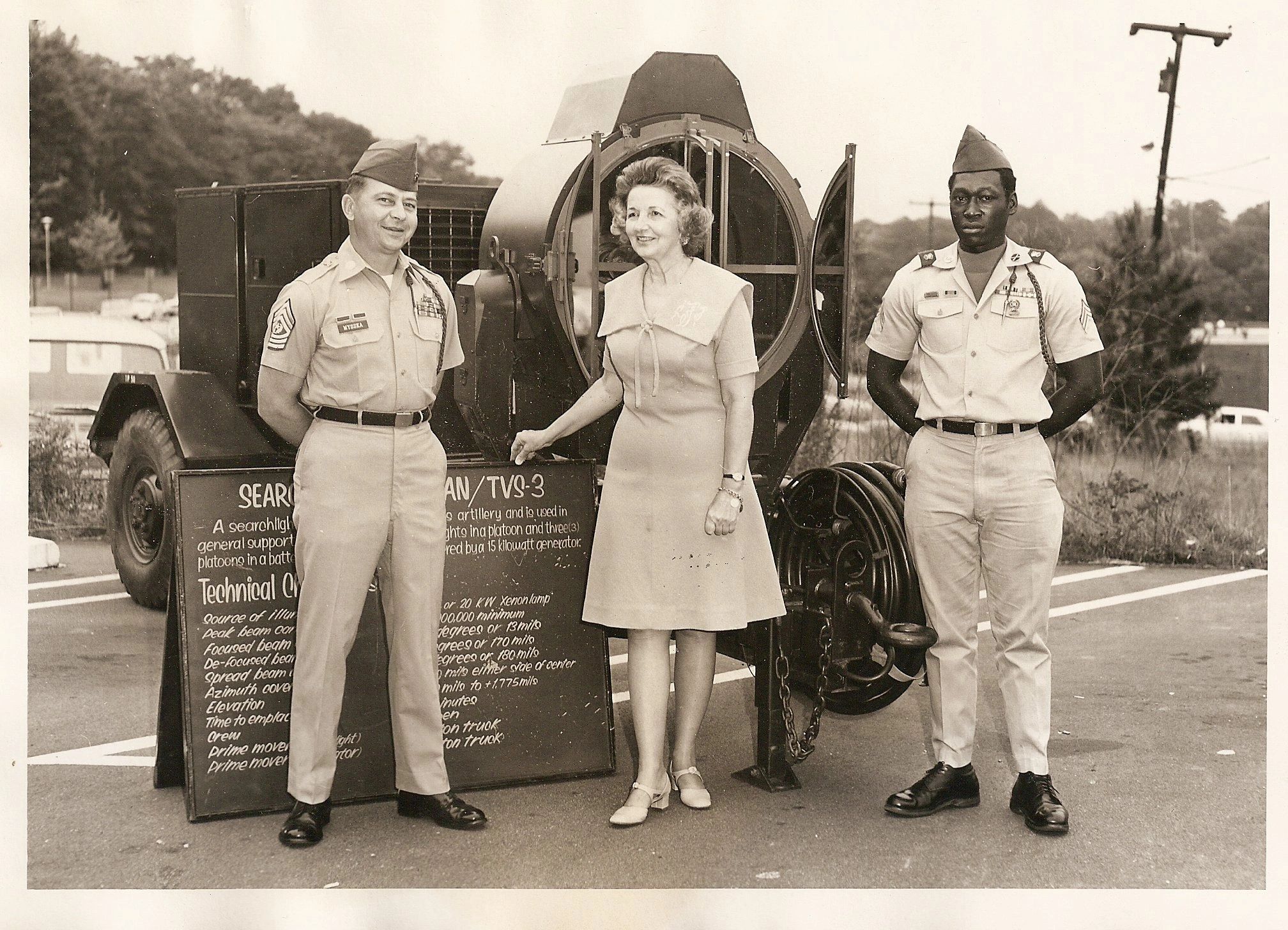
Several AN/TVS 3's were sent to Vietnam for testing. According to Army reports that are now declassified, AN/TVS 3's were aimed up into the night skies over operational areas and they provided illumination sufficient to read a newspaper 20 - 30 kilometers away. The US Army also used the lights to orient and guide aircraft pilots up to 100 kilometers away. In forward areas, the lights were used for base perimeter protection and to direct artillery fire. At close range, AN/TVS 3's generated light with approximately the same intensity and color as the sun, making them useful for disorienting enemy soldiers. In one reported incident, the lights played an important role in thwarting a large boat-borne attack on US positions along a river bank when the enemy boats seemed to go off-course under the intense blinding light.

A 1970 Bell Laboratory report that I obtained from the internet discusses the feasibility of using AN/TVS 3's as ground beacons to help astronauts aboard the Skylab Space Station visualize targets on earth. Following extensive calculations, the study concluded that these searchlights were plenty bright enough to be seen from orbit, thereby confirming that the beam from an AN/TVS 3 could easily reach outer space. I'm told that these lights were also used to help calibrate early GPS satellites.
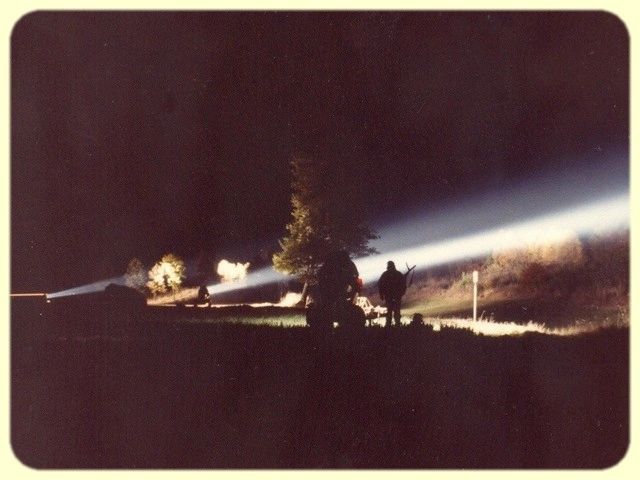
After Vietnam, the US Army decided that visible spectrum searchlights were a liability, since shedding white light on a battlefield provided illumination for both friendly forces and enemy combatants in equal measure. Modern night vision technologies made it possible for US military forces to function without artificial lighting and this gave them a huge advantage over enemies who did not have such technologies. By the late 1970's, many AN/TVS 3's were taken out of service and placed on the surplus market. Most of the remaining searchlights were sent to NASA to illuminate Apollo rockets on the launch pads at Kennedy Space Center. Initially, NASA underestimated the electromechanical interference (EMI) projected by the light and the Apollo computers crashed when the beams were aimed at the rockets on the launch pads. Engineers solved the problem by using hardware store chicken wire to build "Faraday cages" that disrupted the harmful emissions.
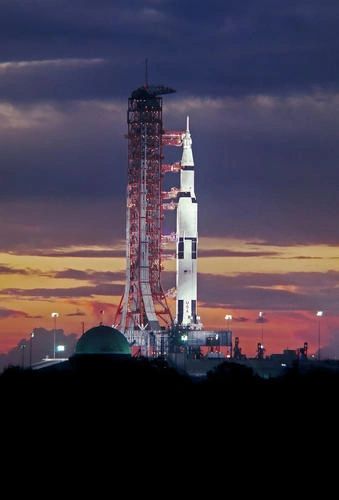
After the US Army decided that it did not need big searchlights anymore, several AN/TVS 3's were sold to the British Army, which continued to operate them for many years. Veterans of the last NATO military searchlight unit maintain a fascinating website at www.873.org.uk . Prior to disbanding in the 1990's the 873 Movement Light Squadron Royal Engineers and their AN/TVS 3's were deployed all over Europe to provide illumination for disaster, rescue, and ceremonial events.
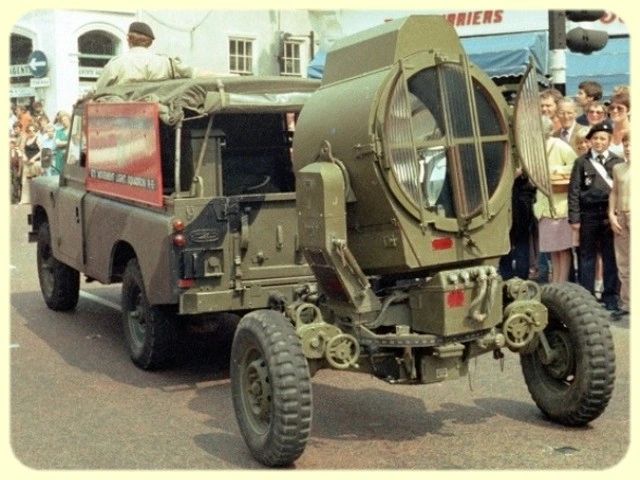
Until the termination of the Space Shuttle Program in 2011, a joint NASA/USAF program deployed over 100 of these searchlights to illuminate numerous launch sites as well as several 10 mile long emergency landing strips in California, Florida, Australia, and Morocco. At the emergency landing strips, 4 lights were positioned at each end of the runway in pairs so that there would be always be lights at the rear of the spacecraft no matter which way it landed. Beginning in the 1990's, NASA/USAF phased out their liquid-cooled AN/TVS 3's and replaced them with more efficient air-cooled units that were not quite as bright.
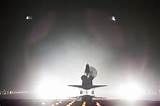
I purchased my first AN/TVS 3 (blue in color) from Dick Cruse, an advertising searchlight operator in Conroe, Texas. Dick had acquired his AN/TVS 3 along with 4 other "parts lights" (in poor condition) from a used car dealer in Oklahoma. The car dealer apparently got the lights originally at a military surplus sale because all the lights had markings from "Cape Canaveral USAF Reservation" . Dick never got the light working. For 20 years or so, Dick focused on other projects while the blue searchlight sat under a thick layer of dust in a shed on Dick's property.
One day, Dick got a visit from a prominent University of Houston physicist who had heard about Dick's searchlights and wanted to purchase a parabolic reflector for his research lab. Dick directed the physicist to the AN/TVS 3 parts lights that were sitting in the weeds behind his shed. Apparently, AN/TVS 3 reflectors are highly desirable because they are plated with Rhodium, a very rare and very expensive metal that is much more durable and much more efficient than chrome. Unable to get such a reflector anywhere else in the civilian world, the physicist took the AN/TVS 3 reflector and used it to conduct some groundbreaking superconductor research. That physicist, Paul Chu, went on to win a Nobel Prize.
When I told Dick that I was looking for a big light to mount on my firetruck, he took me to his shed and showed me the blue searchlight. He told me, "If you want a big light, they don't get any bigger than this. If you manage to get this thing working, then you can shine a damned beam into outer space!" He offered to sell me his AN/TVS 3's, perhaps with the expectation that I too could use them to earn a Nobel Prize. I drove away with the blue searchlight and the remains of all four parts lights. Last I heard, Dick retired from the searchlight business and went to the North Sea where he served as cook on one of the fishing boats featured on the reality cable show "Deadliest Catch". He also had a supercharged Honda motorcycle, but that's a great story for another day...
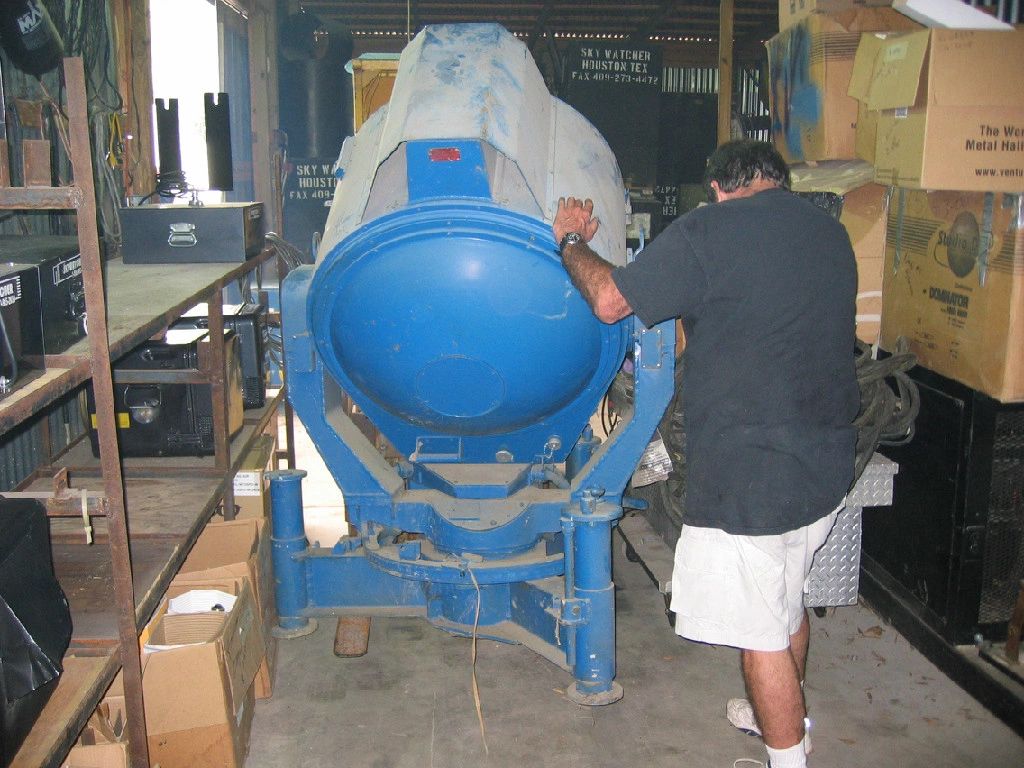
It took two years to get the blue searchlight working. First, I had to find an affordable 400hz generator powerful enough for the light. My first attempts to use an Army surplus gen set only led to several months of frustrations and failures. Then, I tried to modify an inexpensive arc welding generator, but that generator proved too weak. Finally, I purchased a diesel 60KW ground power unit that was being used to power up big airliners at Hobby Airport in Houston. It was not cheap, but at last I had a reliable power supply with enough juice to drive 2 big searchlights.
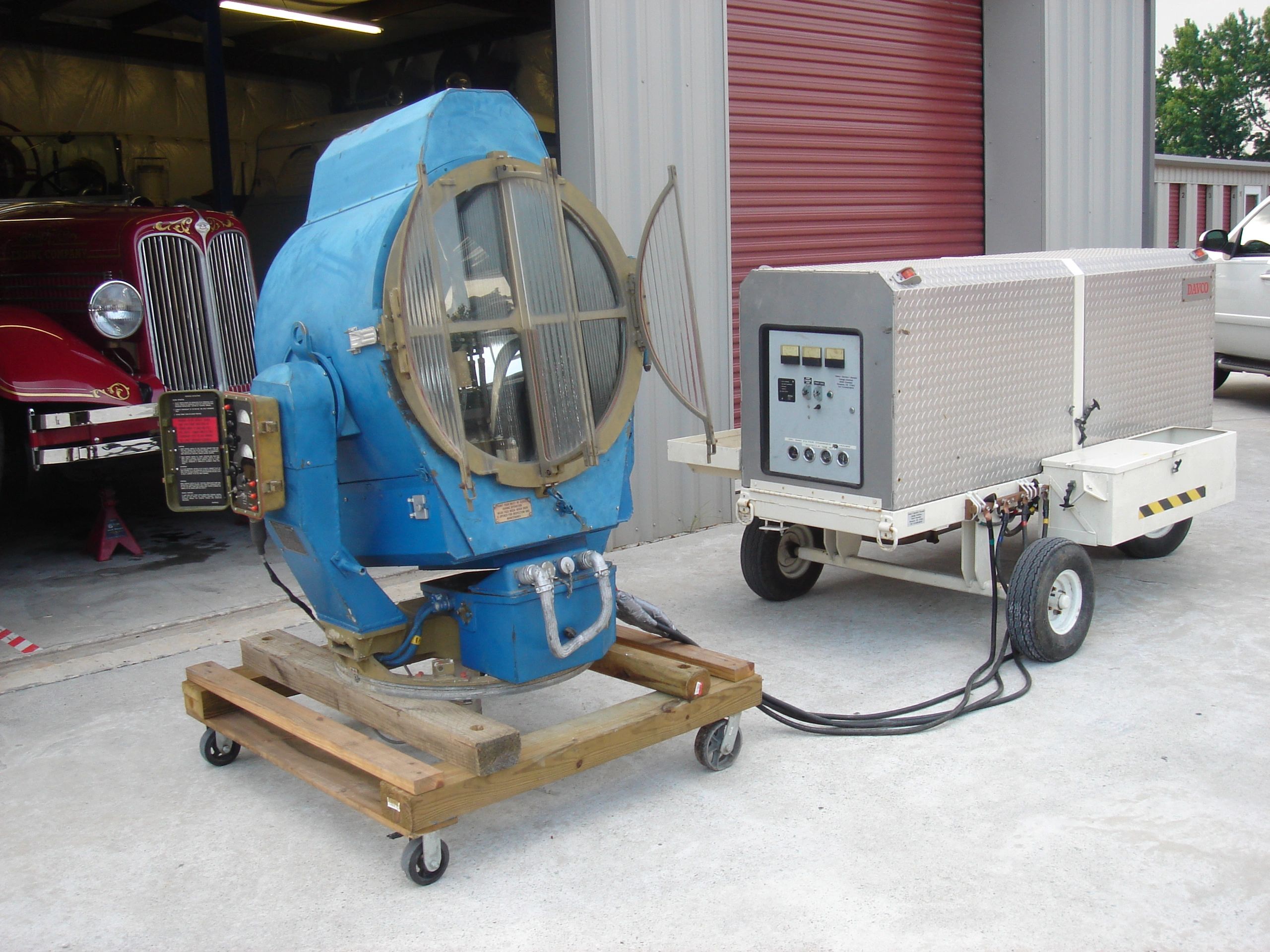
The next big challenge was finding the right coolant for the light. Since both the anode and cathode of the lamp share the same cooling system which routes liquid through both the positive and negative sides of a very high voltage system, conventional water/antifreeze solutions shorted out the light and prevented ignition. I tried to buy the special coolant recommended in the Army technical manuals, but no vendors wanted to sell me government-spec coolant in small quantities. Apparently, NASA and the Army purchased the stuff in 4000-10,000 gallon batches. All I wanted was a few measly gallons of "searchlight antifreeze". I found nothing but dead ends for a while. Finally, I learned that my AN/TVS 3 xenon lamps are very similar to the liquid-cooled xenon lamps used in IMAX theater projectors. So, I followed IMAX recommendations and mixed pure ethyl glycol with lab-grade deionized water to create my own home-brewed non-conductive coolant. It worked!
That first night, I operated my AN/TVS 3 on the driveway next to my house for almost an hour before my neighbor called the police.
This is me setting my neighbor's tree top on fire.
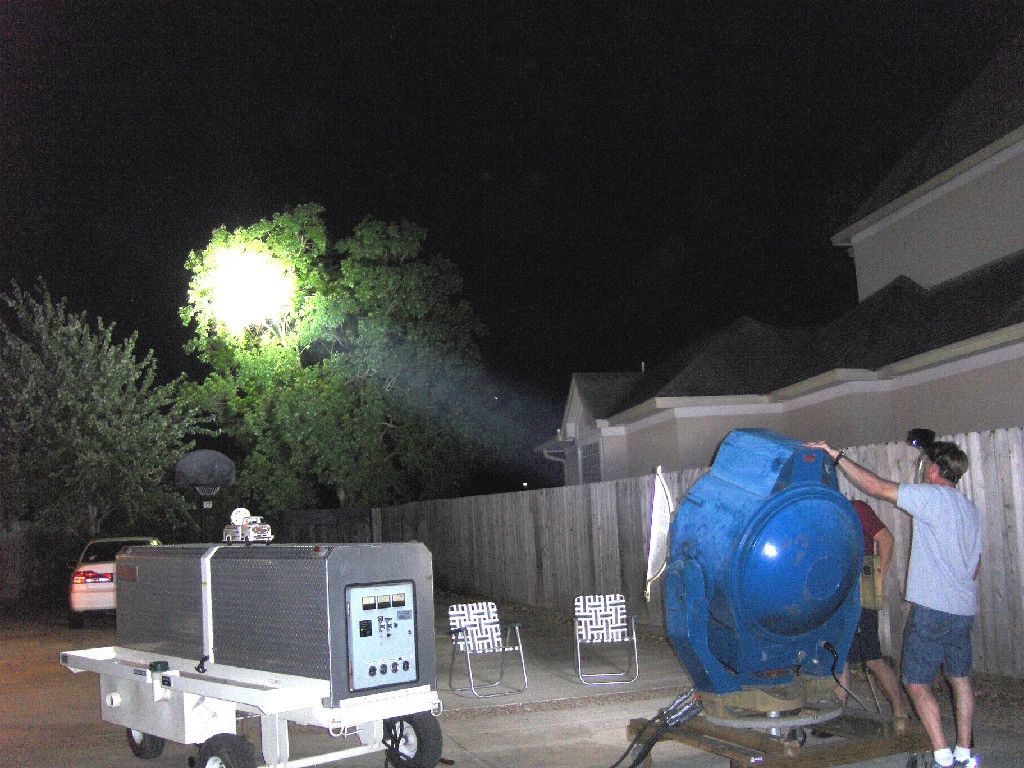
This is me moving the light around the sky and feeling like I was waving the finger of God. My neighbor was apparently unimpressed.
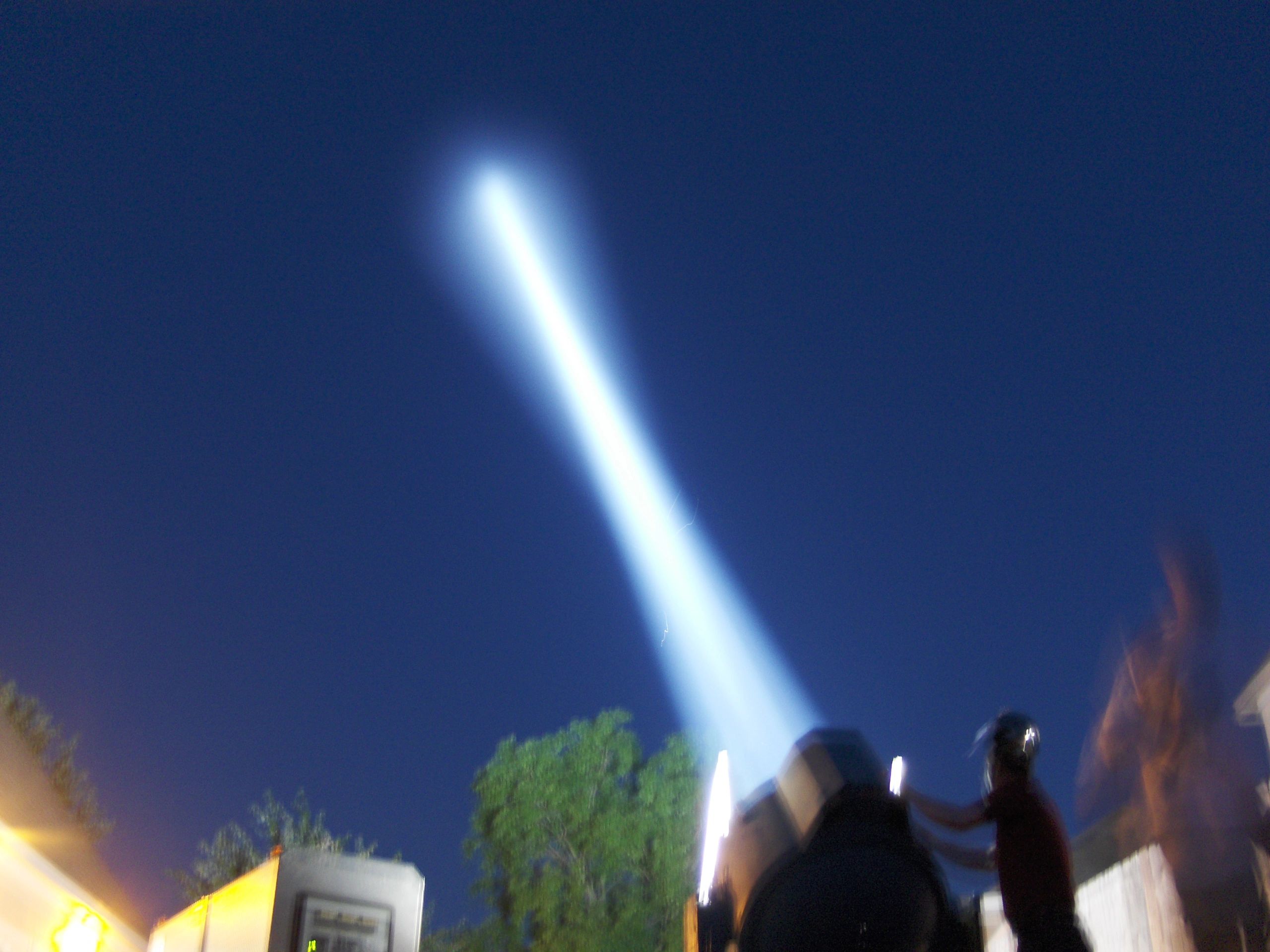
This photo shows the light oriented straight up toward the sky with the bottom service cover removed. Exposed are the rather complex electronic controls, ignition systems, and cooling systems. There certainly are a lot of moving parts for a device that is basically nothing more that a great big flashlight! The small gauge wiring is Teflon coated and each wire is carefully marked with coded numbers that correspond with the large schematic etched on the inside of the service cover. The large gauge wires are wrapped in layers of asbestos and silicone. The entire chassis is solid aluminum, as are the housings. All fasteners are stainless steel. The wires are pure silver. The contacts are all plated in 24ct gold. The electronics remind me of early space program technology. Very heavy duty and very neat. I'm told that cold war military electronics were built to survive the worst possible conditions, including nuclear war. Nice to know that my lights will still be working no matter how bad things get. Apparently, I will still be able to light up the night sky even after the zombie apocalypse.
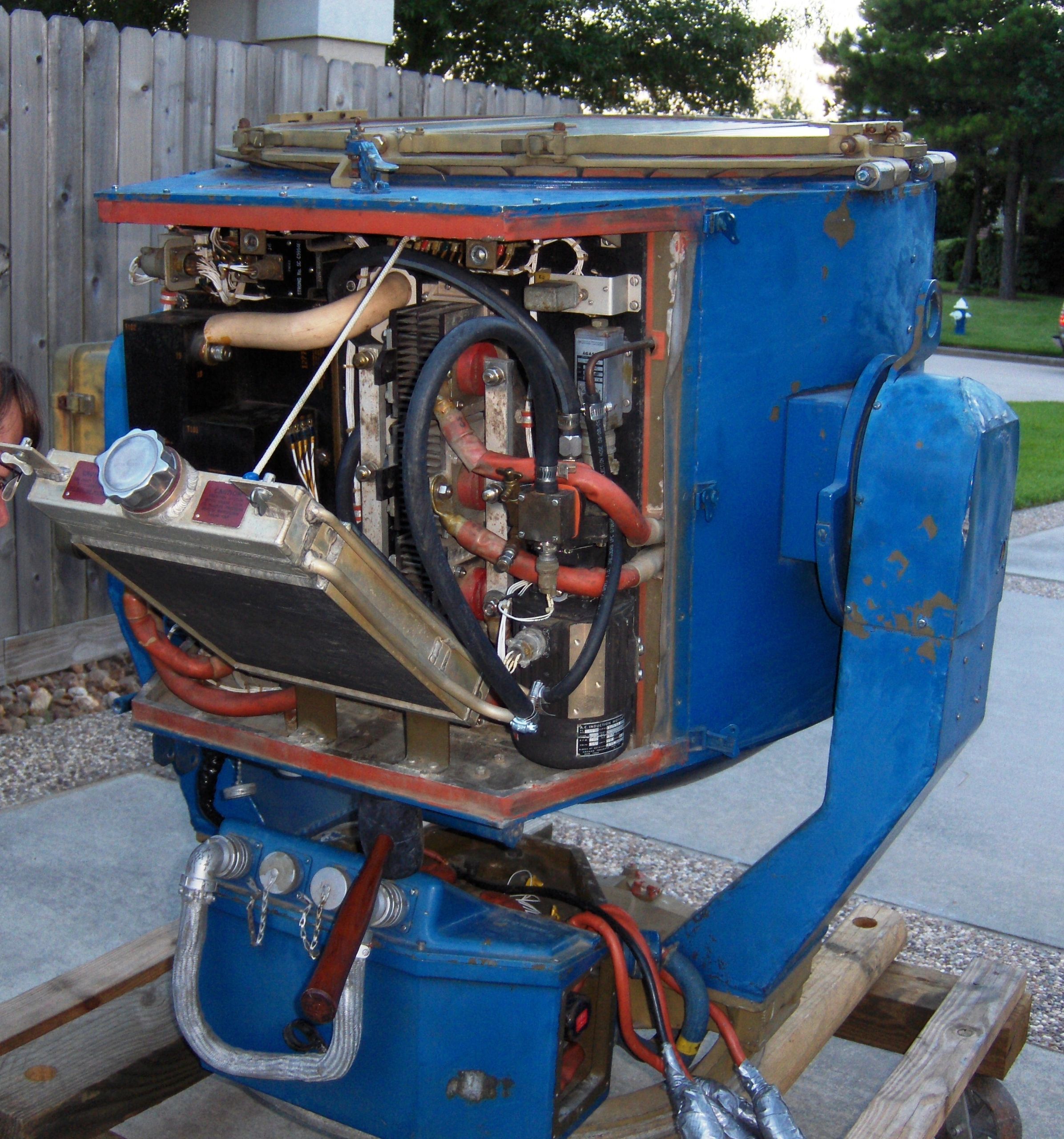
About three or four years into my searchlight truck project, I started to worry about replacement parts. By that point, it was clear to me that the project was going to require a substantial investment of both time and money. The searchlight I had chosen for the project, the AN/TVS 3, is freaking awesome to be sure, but it is also a model that was long ago discontinued. As far as I knew at the time, I was the only civilian in the world operating this model searchlight. So, obviously, there seemed to be no civilian aftermarket for parts. I began to scour the internet for military surplus lights and parts. Eventually, I stumbled onto three intact lights for sale in San Jose, California. They were US Army lights, complete with lamps, and still in their original configuration. An advertising searchlight operator purchased them over 20 years ago and, like Dick Cruse, he never got around to starting them up. They were low-hour lights, with only 12 hours, 5 hours, and 2 hours of operating time on their meters. They must have been virtually new lights when placed into surplus, but time had not been kind to them since retirement. After sitting outside in the elements for over 20 years, they exhibited considerable damage from weather, small animals, and vandals. Still, these were virtually complete units, and two of the three lights had decent lamps. So, I purchased all three lights and shipped them to Texas to join my fleet.
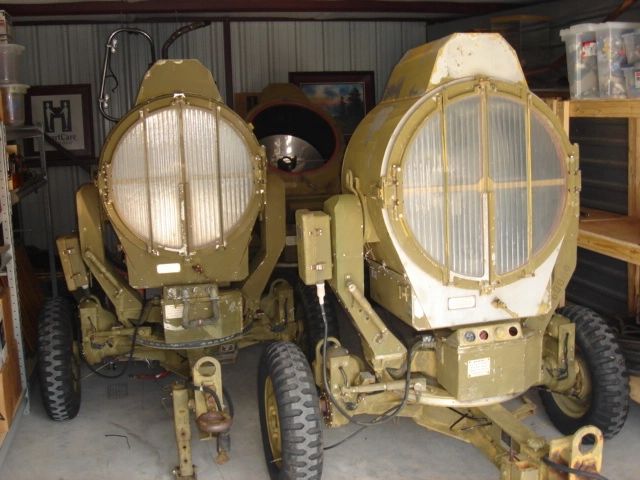
Around the time I purchased the San Jose lights, I got a lead that eventually put me in contact with George Bieman, who was the supervising technician who oversaw NASA's fleet of AN/TVS 3's in Florida. George turned out to be a great resource for all my unanswered questions. He spent many hours with me on the phone providing invaluable advice on operating and maintaining my lights. Without his assistance, I may have gotten discouraged and quit my project.
My next big break came in 2012 when I was contacted by Neal Strickberger, a guy in San Francisco who found my website through Candlepower Forum, a chat site for people who share my fetish for high powered flashlights ("flashaholics"). Neal is an investor, engineer, artist, and renaissance man who located a large cache of AN/TVS 3's in an industrial salvage yard in Pennsylvania. Neal and I combined our resources to purchase the lot of 10 searchlights plus pallets full of OEM replacement parts. Neal took possession of the lights and I took a portion of the spare parts.
This is Neal and his lights at his Treasure Island Hangar/Art Studio:
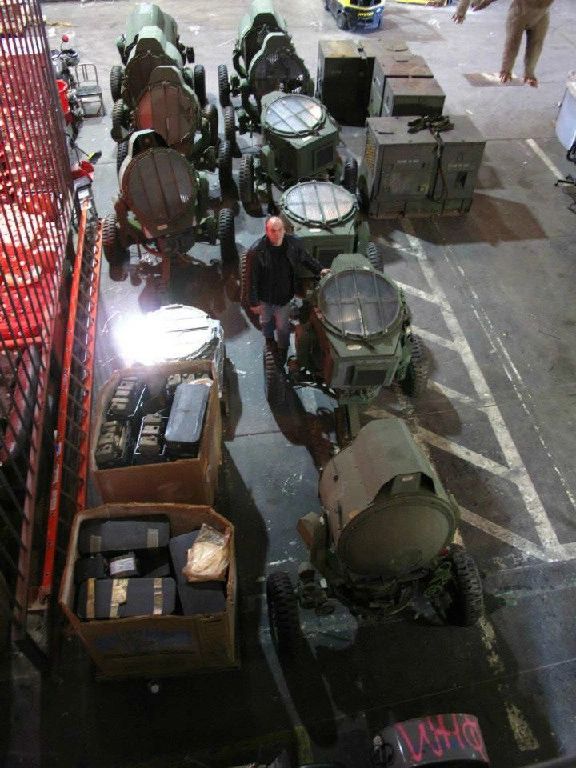
Neal is some kind of organizational, mechanical, and electronic genius, so when he put his lights in operational condition, he also resolved most of the remaining technical problems that I had with my light. For instance, he figured out how to put anticorrosive additives into the coolant formula. He also started some kind of searchlight nerd club that developed a way to automate AN/TVS 3's with 24 volt scooter motors so that the beams can be remotely controlled by iPads and iPhones.
He took his lights to Burning Man every year beginning in 2013, and I think there are some good Youtube videos of his searchlight beams over the Playa. Neal also does artsy stuff with his lights over San Francisco Bay.
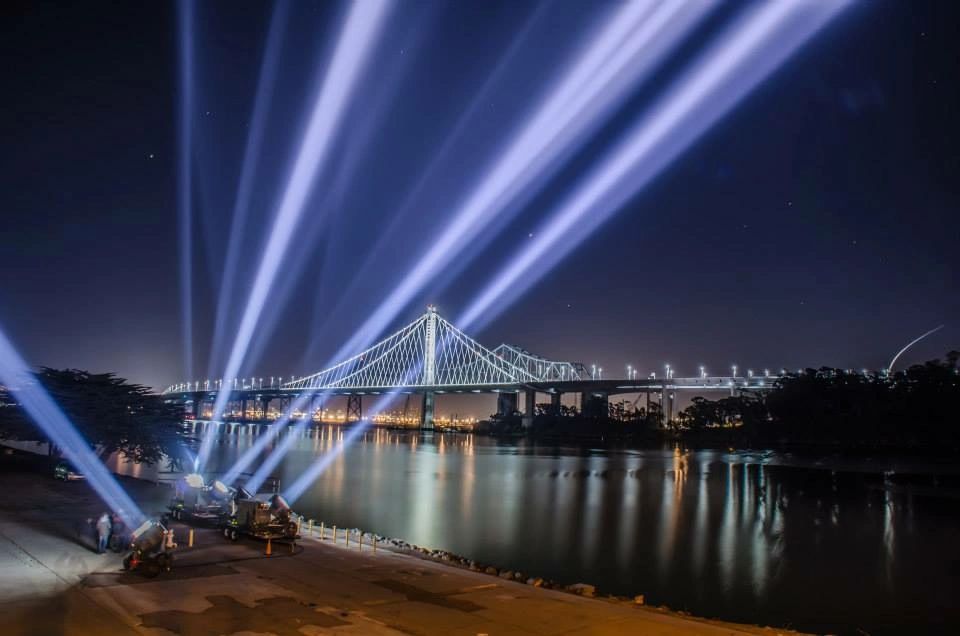
My last big worry concerned lamp replacements. Uncle Sam paid $6,000 apiece for those 20KW xenon lamps back in the 1960's. Superior Quartz Lamps Inc., the company that made all the original lamps, hasn't made any 20KW xenon lamps since the military stopped ordering them many years ago. But, they offered to custom manufacture a few lamps for me for about $8,000 a piece. Ugh. So, I obviously could not afford new replacement lamps. According to the spec sheets, the service life of those lamps is only about 400 hours or 400 starts under ideal conditions. I did not expect to get that much service from my 3 well-used lamps because, even if some of my lamps had logged low hours, they were all still over 40 years old. What was I to do after my 3 lamps reached the end of their operating lives? I had to find a supply of lamps somehow. Starting in 2012, Neal and I devoted a lot of effort to finding all the lamps that might still be floating around in the surplus market. By shear luck, and with some help from a newly discovered AN-TVS-3 owner in North Carolina, Richard Kohl, I found several brand new lamps for sale. On Ebay!
In 2014, George Bierman notified us that NASA/USAF decided to "demilitarize" (destroy) all 98 of their decommissioned AN/TVS 3's that had been pooled in Florida after the demise of the Space Shuttle Program. Tragically, none of the lamps from those units were saved. Then we got a lucky break. The NASA facility at Edwards AFB in California had 16 lights that were also destroyed, but not before somebody removed the lamps and placed them into the government surplus liquidation system. I placed a winning bid on the lot of 16 lamps and, soon after, Neal and I met at Edwards AFB to divide them up. Since all the Edwards lamps had been recently removed from active service lights, they were mostly in pretty good shape. Finally! I had all the parts I needed to keep my AN/TVS 3's going for my lifetime and maybe beyond.
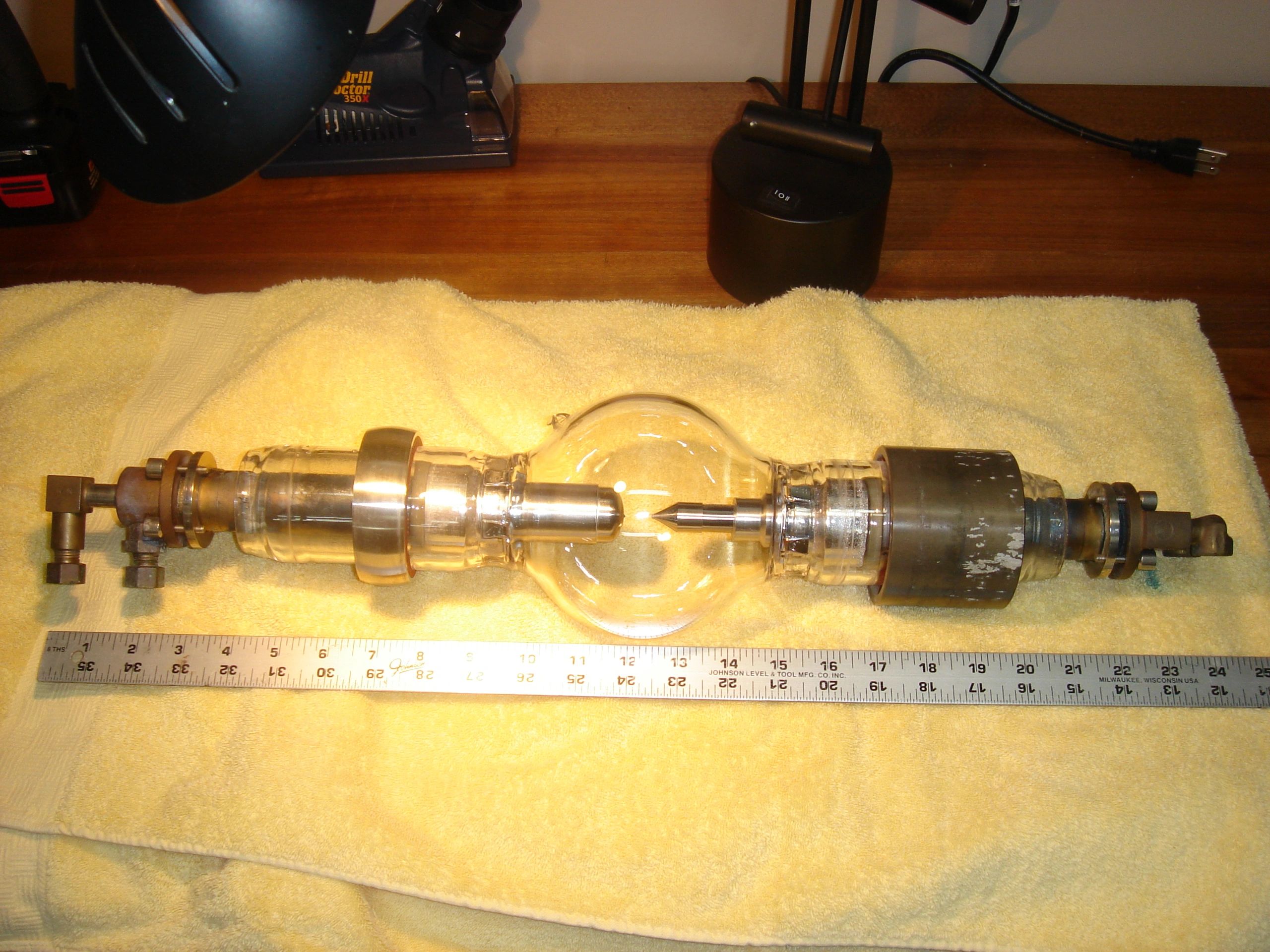
Now that all the NASA/USAF lights are gone, there must only be a handful of operational AN/TVS 3 searchlights remaining from the original inventory of 200. We know of a city in Alabama that acquired four lights from the US Army via Intergovernmental Surplus Property Transfer, and they used them to draw attention to special events. Those lights were eventually resold, but we are not sure where they ended up. We are in frequent contact with Richard Kohl in North Carolina who often fires up his AN/TVS 3 at local charity events. Neal has about 10 lights in operating condition. I have 4. Other than that, we know of no other active AN/TVS 3 Searchlight operators. There are a number of static display AN/TVS 3's in museums throughout the USA and Britain. But, as far as we know, none of the museums are actually operating their lights. I personally parted out 4 lights and I am personally familiar with another 30 or so junked or parted out lights. When we total up the numbers, I think that we have accounted for almost all of the lights. Are there any more out there in good condition? Doubtful. But, maybe.
Many of us who lived in the 1960's and 1970's remember seeing big WWII carbon arc antiaircraft searchlights in use for advertising and special events on a fairly regular basis. They were pretty common back in those days because so many of those 60 inch lights were manufactured during the war, over 20,000 in all. After the war, most of those lights got sold cheap to anybody who wanted to shine a big light in the sky. Evidently, a lot of people wanted to shine a big light in the sky. That iconic image of searchlight beams shining in the sky at celebrations and grand openings was a direct result of war surplus searchlights flooding the civilian market after WWII. There are still abundant parts and supplies for those big WWII lights, if you know where to look. Sadly, those WWII lights are all over 75 years old now and they (as well as the people interested in maintaining them) are becoming rarer with each passing year. Thankfully, there are still a small number of hobbyists who are actively restoring and preserving 60 inch carbon arc searchlights for future generations. See www.victorysearchlights.com
So, who is going to preserve AN/TVS 3's, the more powerful lights that replaced the 60" carbon arc's?
I guess that'll be me, Neal, and Richard. anyone else out there?
May 2018 Update:
I decided to remove the AN/TVS 3 from my searchlight truck. The reasons are kind of complicated, but I offer a short explanation on My Searchlight Truck page. After liberating the searchlight from the truck project, I decided to combine it with parts from one of my spare searchlights to create a single, complete, operating searchlight in its original Army configuration.
Here is a photo of the light after I finished the restoration. It is as perfect as I can make it.
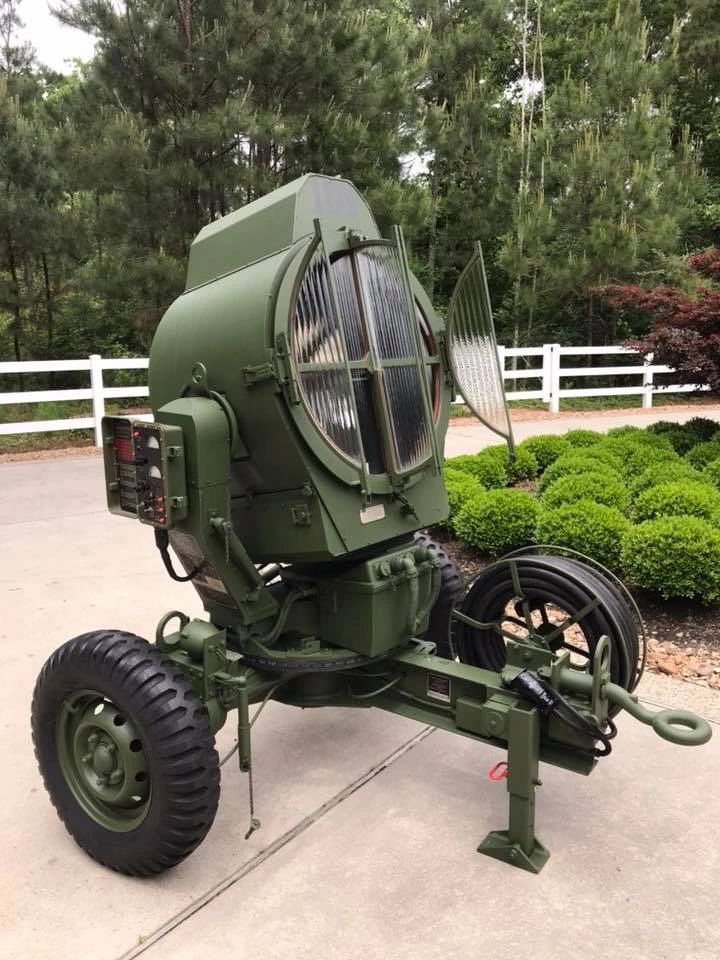
I needed to free up space, so I turned over my spare lights to Dick Kohl. This leaves me with one light. One is enough for me.

I had my generator installed onto a new chassis that is compact enough to push around and store inside. It has an atv winch for pulling itself onto my trailer and then pulling the searchlight behind it. This is a photo of the generator and light loaded up to go to my first legitimate searchlight gig since the restoration, a Chamber of Commerce event called Tomball Night 2018. I will illuminate the skies over the Tomball "Parade of Lights". The city required FAA permission before approving operation of the light for a City event.

Several AN/TVS 3's were sent to Vietnam for testing. According to Army reports that are now declassified, AN/TVS 3's were aimed up into the night skies over operational areas and they provided illumination sufficient to read a newspaper 20 - 30 kilometers away. The US Army also used the lights to orient and guide aircraft pilots up to 100 kilometers away. In forward areas, the lights were used for base perimeter protection and to direct artillery fire. At close range, AN/TVS 3's generated light with approximately the same intensity and color as the sun, making them useful for disorienting enemy soldiers. In one reported incident, the lights played an important role in thwarting a large boat-borne attack on US positions along a river bank when the enemy boats seemed to go off-course under the intense blinding light.

A 1970 Bell Laboratory report that I obtained from the internet discusses the feasibility of using AN/TVS 3's as ground beacons to help astronauts aboard the Skylab Space Station visualize targets on earth. Following extensive calculations, the study concluded that these searchlights were plenty bright enough to be seen from orbit, thereby confirming that the beam from an AN/TVS 3 could easily reach outer space. I'm told that these lights were also used to help calibrate early GPS satellites.

After Vietnam, the US Army decided that visible spectrum searchlights were a liability, since shedding white light on a battlefield provided illumination for both friendly forces and enemy combatants in equal measure. Modern night vision technologies made it possible for US military forces to function without artificial lighting and this gave them a huge advantage over enemies who did not have such technologies. By the late 1970's, many AN/TVS 3's were taken out of service and placed on the surplus market. Most of the remaining searchlights were sent to NASA to illuminate Apollo rockets on the launch pads at Kennedy Space Center. Initially, NASA underestimated the electromechanical interference (EMI) projected by the light and the Apollo computers crashed when the beams were aimed at the rockets on the launch pads. Engineers solved the problem by using hardware store chicken wire to build "Faraday cages" that disrupted the harmful emissions.

After the US Army decided that it did not need big searchlights anymore, several AN/TVS 3's were sold to the British Army, which continued to operate them for many years. Veterans of the last NATO military searchlight unit maintain a fascinating website at www.873.org.uk . Prior to disbanding in the 1990's the 873 Movement Light Squadron Royal Engineers and their AN/TVS 3's were deployed all over Europe to provide illumination for disaster, rescue, and ceremonial events.

Until the termination of the Space Shuttle Program in 2011, a joint NASA/USAF program deployed over 100 of these searchlights to illuminate numerous launch sites as well as several 10 mile long emergency landing strips in California, Florida, Australia, and Morocco. At the emergency landing strips, 4 lights were positioned at each end of the runway in pairs so that there would be always be lights at the rear of the spacecraft no matter which way it landed. Beginning in the 1990's, NASA/USAF phased out their liquid-cooled AN/TVS 3's and replaced them with more efficient air-cooled units that were not quite as bright.

I purchased my first AN/TVS 3 (blue in color) from Dick Cruse, an advertising searchlight operator in Conroe, Texas. Dick had acquired his AN/TVS 3 along with 4 other "parts lights" (in poor condition) from a used car dealer in Oklahoma. The car dealer apparently got the lights originally at a military surplus sale because all the lights had markings from "Cape Canaveral USAF Reservation" . Dick never got the light working. For 20 years or so, Dick focused on other projects while the blue searchlight sat under a thick layer of dust in a shed on Dick's property.
One day, Dick got a visit from a prominent University of Houston physicist who had heard about Dick's searchlights and wanted to purchase a parabolic reflector for his research lab. Dick directed the physicist to the AN/TVS 3 parts lights that were sitting in the weeds behind his shed. Apparently, AN/TVS 3 reflectors are highly desirable because they are plated with Rhodium, a very rare and very expensive metal that is much more durable and much more efficient than chrome. Unable to get such a reflector anywhere else in the civilian world, the physicist took the AN/TVS 3 reflector and used it to conduct some groundbreaking superconductor research. That physicist, Paul Chu, went on to win a Nobel Prize.
When I told Dick that I was looking for a big light to mount on my firetruck, he took me to his shed and showed me the blue searchlight. He told me, "If you want a big light, they don't get any bigger than this. If you manage to get this thing working, then you can shine a damned beam into outer space!" He offered to sell me his AN/TVS 3's, perhaps with the expectation that I too could use them to earn a Nobel Prize. I drove away with the blue searchlight and the remains of all four parts lights. Last I heard, Dick retired from the searchlight business and went to the North Sea where he served as cook on one of the fishing boats featured on the reality cable show "Deadliest Catch". He also had a supercharged Honda motorcycle, but that's a great story for another day...

It took two years to get the blue searchlight working. First, I had to find an affordable 400hz generator powerful enough for the light. My first attempts to use an Army surplus gen set only led to several months of frustrations and failures. Then, I tried to modify an inexpensive arc welding generator, but that generator proved too weak. Finally, I purchased a diesel 60KW ground power unit that was being used to power up big airliners at Hobby Airport in Houston. It was not cheap, but at last I had a reliable power supply with enough juice to drive 2 big searchlights.

The next big challenge was finding the right coolant for the light. Since both the anode and cathode of the lamp share the same cooling system which routes liquid through both the positive and negative sides of a very high voltage system, conventional water/antifreeze solutions shorted out the light and prevented ignition. I tried to buy the special coolant recommended in the Army technical manuals, but no vendors wanted to sell me government-spec coolant in small quantities. Apparently, NASA and the Army purchased the stuff in 4000-10,000 gallon batches. All I wanted was a few measly gallons of "searchlight antifreeze". I found nothing but dead ends for a while. Finally, I learned that my AN/TVS 3 xenon lamps are very similar to the liquid-cooled xenon lamps used in IMAX theater projectors. So, I followed IMAX recommendations and mixed pure ethyl glycol with lab-grade deionized water to create my own home-brewed non-conductive coolant. It worked!
That first night, I operated my AN/TVS 3 on the driveway next to my house for almost an hour before my neighbor called the police.
This is me setting my neighbor's tree top on fire.

This is me moving the light around the sky and feeling like I was waving the finger of God. My neighbor was apparently unimpressed.

This photo shows the light oriented straight up toward the sky with the bottom service cover removed. Exposed are the rather complex electronic controls, ignition systems, and cooling systems. There certainly are a lot of moving parts for a device that is basically nothing more that a great big flashlight! The small gauge wiring is Teflon coated and each wire is carefully marked with coded numbers that correspond with the large schematic etched on the inside of the service cover. The large gauge wires are wrapped in layers of asbestos and silicone. The entire chassis is solid aluminum, as are the housings. All fasteners are stainless steel. The wires are pure silver. The contacts are all plated in 24ct gold. The electronics remind me of early space program technology. Very heavy duty and very neat. I'm told that cold war military electronics were built to survive the worst possible conditions, including nuclear war. Nice to know that my lights will still be working no matter how bad things get. Apparently, I will still be able to light up the night sky even after the zombie apocalypse.

About three or four years into my searchlight truck project, I started to worry about replacement parts. By that point, it was clear to me that the project was going to require a substantial investment of both time and money. The searchlight I had chosen for the project, the AN/TVS 3, is freaking awesome to be sure, but it is also a model that was long ago discontinued. As far as I knew at the time, I was the only civilian in the world operating this model searchlight. So, obviously, there seemed to be no civilian aftermarket for parts. I began to scour the internet for military surplus lights and parts. Eventually, I stumbled onto three intact lights for sale in San Jose, California. They were US Army lights, complete with lamps, and still in their original configuration. An advertising searchlight operator purchased them over 20 years ago and, like Dick Cruse, he never got around to starting them up. They were low-hour lights, with only 12 hours, 5 hours, and 2 hours of operating time on their meters. They must have been virtually new lights when placed into surplus, but time had not been kind to them since retirement. After sitting outside in the elements for over 20 years, they exhibited considerable damage from weather, small animals, and vandals. Still, these were virtually complete units, and two of the three lights had decent lamps. So, I purchased all three lights and shipped them to Texas to join my fleet.

Around the time I purchased the San Jose lights, I got a lead that eventually put me in contact with George Bieman, who was the supervising technician who oversaw NASA's fleet of AN/TVS 3's in Florida. George turned out to be a great resource for all my unanswered questions. He spent many hours with me on the phone providing invaluable advice on operating and maintaining my lights. Without his assistance, I may have gotten discouraged and quit my project.
My next big break came in 2012 when I was contacted by Neal Strickberger, a guy in San Francisco who found my website through Candlepower Forum, a chat site for people who share my fetish for high powered flashlights ("flashaholics"). Neal is an investor, engineer, artist, and renaissance man who located a large cache of AN/TVS 3's in an industrial salvage yard in Pennsylvania. Neal and I combined our resources to purchase the lot of 10 searchlights plus pallets full of OEM replacement parts. Neal took possession of the lights and I took a portion of the spare parts.
This is Neal and his lights at his Treasure Island Hangar/Art Studio:

Neal is some kind of organizational, mechanical, and electronic genius, so when he put his lights in operational condition, he also resolved most of the remaining technical problems that I had with my light. For instance, he figured out how to put anticorrosive additives into the coolant formula. He also started some kind of searchlight nerd club that developed a way to automate AN/TVS 3's with 24 volt scooter motors so that the beams can be remotely controlled by iPads and iPhones.
He took his lights to Burning Man every year beginning in 2013, and I think there are some good Youtube videos of his searchlight beams over the Playa. Neal also does artsy stuff with his lights over San Francisco Bay.

My last big worry concerned lamp replacements. Uncle Sam paid $6,000 apiece for those 20KW xenon lamps back in the 1960's. Superior Quartz Lamps Inc., the company that made all the original lamps, hasn't made any 20KW xenon lamps since the military stopped ordering them many years ago. But, they offered to custom manufacture a few lamps for me for about $8,000 a piece. Ugh. So, I obviously could not afford new replacement lamps. According to the spec sheets, the service life of those lamps is only about 400 hours or 400 starts under ideal conditions. I did not expect to get that much service from my 3 well-used lamps because, even if some of my lamps had logged low hours, they were all still over 40 years old. What was I to do after my 3 lamps reached the end of their operating lives? I had to find a supply of lamps somehow. Starting in 2012, Neal and I devoted a lot of effort to finding all the lamps that might still be floating around in the surplus market. By shear luck, and with some help from a newly discovered AN-TVS-3 owner in North Carolina, Richard Kohl, I found several brand new lamps for sale. On Ebay!
In 2014, George Bierman notified us that NASA/USAF decided to "demilitarize" (destroy) all 98 of their decommissioned AN/TVS 3's that had been pooled in Florida after the demise of the Space Shuttle Program. Tragically, none of the lamps from those units were saved. Then we got a lucky break. The NASA facility at Edwards AFB in California had 16 lights that were also destroyed, but not before somebody removed the lamps and placed them into the government surplus liquidation system. I placed a winning bid on the lot of 16 lamps and, soon after, Neal and I met at Edwards AFB to divide them up. Since all the Edwards lamps had been recently removed from active service lights, they were mostly in pretty good shape. Finally! I had all the parts I needed to keep my AN/TVS 3's going for my lifetime and maybe beyond.

Now that all the NASA/USAF lights are gone, there must only be a handful of operational AN/TVS 3 searchlights remaining from the original inventory of 200. We know of a city in Alabama that acquired four lights from the US Army via Intergovernmental Surplus Property Transfer, and they used them to draw attention to special events. Those lights were eventually resold, but we are not sure where they ended up. We are in frequent contact with Richard Kohl in North Carolina who often fires up his AN/TVS 3 at local charity events. Neal has about 10 lights in operating condition. I have 4. Other than that, we know of no other active AN/TVS 3 Searchlight operators. There are a number of static display AN/TVS 3's in museums throughout the USA and Britain. But, as far as we know, none of the museums are actually operating their lights. I personally parted out 4 lights and I am personally familiar with another 30 or so junked or parted out lights. When we total up the numbers, I think that we have accounted for almost all of the lights. Are there any more out there in good condition? Doubtful. But, maybe.
Many of us who lived in the 1960's and 1970's remember seeing big WWII carbon arc antiaircraft searchlights in use for advertising and special events on a fairly regular basis. They were pretty common back in those days because so many of those 60 inch lights were manufactured during the war, over 20,000 in all. After the war, most of those lights got sold cheap to anybody who wanted to shine a big light in the sky. Evidently, a lot of people wanted to shine a big light in the sky. That iconic image of searchlight beams shining in the sky at celebrations and grand openings was a direct result of war surplus searchlights flooding the civilian market after WWII. There are still abundant parts and supplies for those big WWII lights, if you know where to look. Sadly, those WWII lights are all over 75 years old now and they (as well as the people interested in maintaining them) are becoming rarer with each passing year. Thankfully, there are still a small number of hobbyists who are actively restoring and preserving 60 inch carbon arc searchlights for future generations. See www.victorysearchlights.com
So, who is going to preserve AN/TVS 3's, the more powerful lights that replaced the 60" carbon arc's?
I guess that'll be me, Neal, and Richard. anyone else out there?
May 2018 Update:
I decided to remove the AN/TVS 3 from my searchlight truck. The reasons are kind of complicated, but I offer a short explanation on My Searchlight Truck page. After liberating the searchlight from the truck project, I decided to combine it with parts from one of my spare searchlights to create a single, complete, operating searchlight in its original Army configuration.
Here is a photo of the light after I finished the restoration. It is as perfect as I can make it.

I needed to free up space, so I turned over my spare lights to Dick Kohl. This leaves me with one light. One is enough for me.

I had my generator installed onto a new chassis that is compact enough to push around and store inside. It has an atv winch for pulling itself onto my trailer and then pulling the searchlight behind it. This is a photo of the generator and light loaded up to go to my first legitimate searchlight gig since the restoration, a Chamber of Commerce event called Tomball Night 2018. I will illuminate the skies over the Tomball "Parade of Lights". The city required FAA permission before approving operation of the light for a City event.
